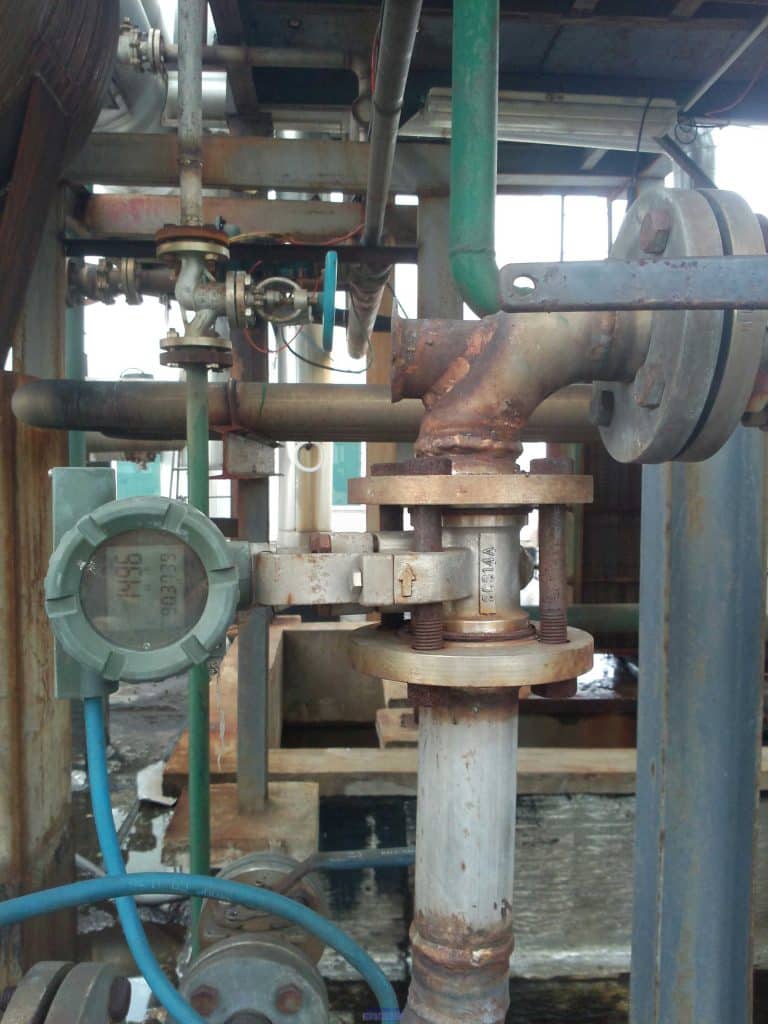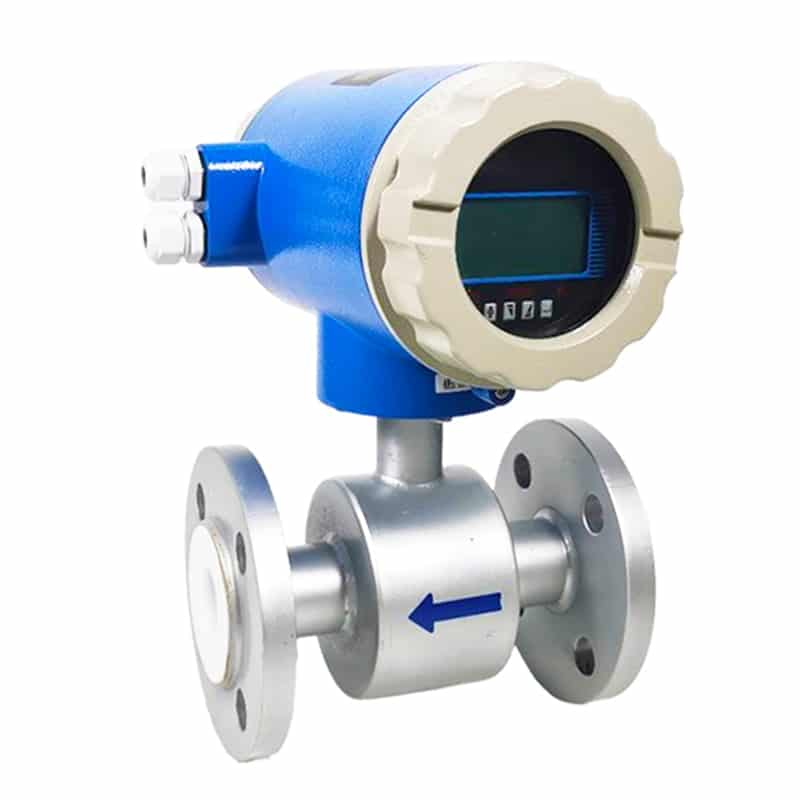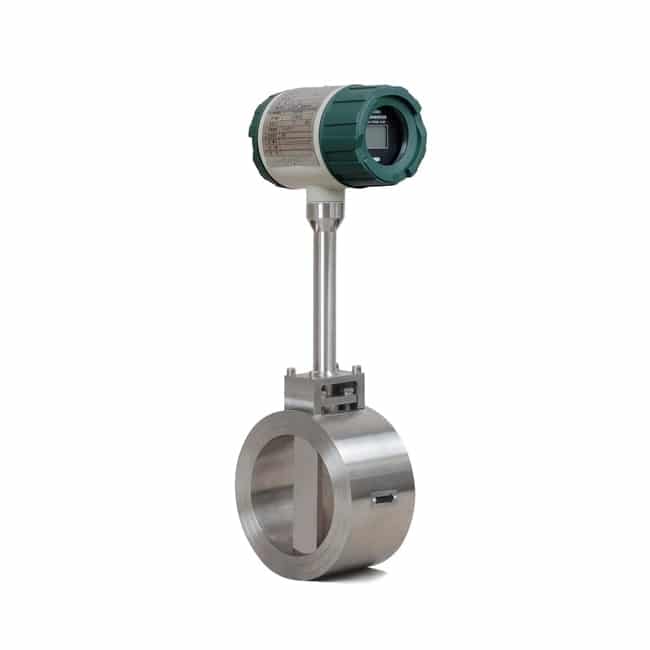What is a turbine flow meter?

A turbine flow meter is an instrument used to measure the flow rate and volume of a liquid or gaseous fluid. It works on the principle of turbine rotation. A turbine flow meter consists of a pipe or fluid channel with turbine blades inside, and as the fluid passes through the channel, the kinetic energy of the fluid pushes the turbine blades and causes them to rotate.
What does a turbine flow meter consist of?
- Turbine blade: one of the core components of the turbine flow meter, the turbine blade is a set of rotating blades usually fixed on the shaft, installed in the channel through which the fluid flows. When the fluid passes through the channel, the turbine blades will be subjected to kinetic energy and rotate. The number and shape of the turbine blades may vary depending on the design of the meter.
- Shaft: The turbine blades are attached to a shaft, which is responsible for transmitting the rotational motion of the turbine blades to the sensor for measurement.
- Sensors: The sensors built into the turbine flow meter are usually magnetic or photoelectric sensors that detect the rotation of the turbine blades. These sensors sense where the turbine blades are passing over them and generate an electrical signal.
- Signal processor: The signals generated by the sensors are transmitted to the turbine flow meter’s signal processor. The signal processor records the rotational frequency of the turbine blades, usually in the form of a number of pulses or a voltage signal.
- Display or output interface: Turbine flow meters are usually equipped with a display or digital output interface for displaying flow rate and flow data, or for transmitting data to an external monitoring system.
- Housing and connections: Turbine flow meters are typically installed in a pipe or fluid path and have an external protective housing and connections to ensure fluid flow through the turbine blades and to protect the internal components.
Working principle of turbine flow meter
- Fluid flow through turbine blades: As a liquid or gaseous fluid passes through the pipe or flow channel of a turbine flow meter, the kinetic energy of the fluid is transferred to the turbine blades. The turbine blades are located in the channel through which the fluid flows and are usually fixed to a shaft.
- Rotates the turbine blades: the flow of fluid causes the turbine blades to begin to rotate. The higher the flow rate, the faster the turbine blades rotate. The rotation of the turbine blades is based on the principle of conservation of momentum, in which the kinetic energy of the fluid is converted into mechanical energy.
Turbine flow signal generation
- Sensors to detect turbine blade rotation: In turbine flow meters, one or more sensors, such as magnetic or photoelectric sensors, are usually included. These sensors are mounted inside the flow meter and are used to detect the rotation of the turbine blades. Each time the turbine blade rotates, the sensor detects a signal or pulse.
- Conversion to electrical signals: The signals generated by the sensors are usually output in the form of electrical signals, which can be a number of pulses or voltage signals. The frequency of these signals is proportional to the speed of rotation of the turbine blades.
Turbine flow meter accuracy
- Flow rate calculation: By measuring the rotational frequency of the turbine blades, the turbine flow meter can calculate the flow rate of the fluid. The flow rate is proportional to the rotational frequency of the turbine blades. The following formula is commonly used for flow rate calculations: Flow Rate (V) = K × f, where V is the flow rate, K is the coefficient of the flow meter, and f is the frequency of the sensor output.
- Flow calculation: Once the flow rate has been determined, the flow rate can be calculated by multiplying the flow rate by the cross-sectional area of the pipe. Flow (Q) = V × A, where Q denotes the flow rate, V is the flow velocity, and A is the cross-sectional area of the pipe.
The measurement accuracy of a turbine flow meter usually depends on several factors, including the following:
- Sensor accuracy: The accuracy of the sensor’s detection of the turbine blade rotation will directly affect the accuracy of the flow rate and flow measurement.
- Fluid Characteristics: Turbine flow meters are sensitive to the nature of the fluid (e.g., viscosity, temperature, and density), so corrections or compensations may be required under specific fluid conditions.
- Cleanliness: The presence of solid particles or impurities in the fluid may affect the rotation of the turbine blades, thereby affecting measurement accuracy.
- Installation and calibration: Proper installation and regular calibration are key factors in ensuring the accuracy of a turbine flow meter.

Do you need a high flow rate model of turbine flow meter for wastewater treatment?
Wastewater treatment usually does not require the use of high flow rate models of turbine flow meters because the flow rates in wastewater treatment processes are usually relatively low. Wastewater treatment usually involves large volumes of wastewater, but this wastewater usually flows through the treatment equipment and piping systems at relatively low flow rates. Therefore, turbine flow meters in the medium flow rate range are generally sufficient to meet the flow measurement needs of wastewater treatment.
Advantages and limitations of turbine flow meters
The turbine flow meter as a flow measurement device has several advantages and limitations. The main advantages and limitations are listed below:
Advantage:
- High accuracy: Turbine flow meters typically provide highly accurate flow measurements and are suitable for applications requiring high accuracy, such as industrial process control and scientific experiments.
- Fast response time: They have a fast response time to quickly capture and react to changes in flow rate, suitable for applications requiring real-time monitoring.
- Wide range of applications: Turbine flow meters are suitable for a wide range of flow rates, from low to high flow rates, and therefore provide reliable measurements in a variety of applications.
- Corrosion resistance: They can be used to measure a wide range of liquids and gases with good corrosion resistance, suitable for applications dealing with corrosive media.
- No direct contact with the fluid: Turbine flow meters do not require direct contact with the fluid, which helps to minimize the impact on the nature of the fluid, especially for applications where contamination needs to be avoided.
Limitations:
- High cleanliness requirements: Turbine flow meter requires high cleanliness of the fluid, because dirt or particulate matter may affect the rotation of the turbine blade, resulting in inaccurate measurement.
- Viscosity-sensitive: the accuracy of the turbine flow meter may be affected by the viscosity of the fluid, for high-viscosity liquids, the need for specially designed turbine flow meter.
- Restricted flow rate range: Although the turbine flow meter is suitable for a wide range of flow rates, it may not be as accurate as other types of flow meters at very low and very high flow rates.
- Requires regular maintenance: Turbine flow meters require regular maintenance and calibration to ensure their performance and accuracy. This may require additional time and cost.
- Not suitable for fluids with a high bubble content: Turbine flow meters are less suitable for liquids with a high bubble content, as the bubbles may affect the rotation of the turbine blades, resulting in inaccurate measurements.
Turbine flow meter sizing and selection, optimal selection and application recommendations
Best choice advice:
- Accuracy requirements: If your application has strict requirements for high-precision flow measurement, it is recommended to choose a turbine flow meter with high resolution and accuracy (LWGY Liquid Turbine Flow Meter).
- Flow range: Consider the flow range to be measured. Select a turbine flow meter with a measurement range that includes the expected flow rate range of your application.
- Fluid characteristics: Consider the nature of the liquid or gas you are measuring, such as temperature, viscosity and corrosivity. Ensure that the selected flow meter is capable of stable operation under fluid characteristics and environmental conditions.
- Communication and data requirements: If you need remote monitoring or data logging, choose a flow meter with the appropriate communication interface for easy integration into your monitoring system.
- Installation and maintenance requirements: Consider where and how the turbine flow meter will be installed and maintained correctly. Some models may require less maintenance.
- Environmental conditions: Consider the environmental conditions of the application, such as temperature range, explosion-proof requirements and immunity to interference. Ensure that the selected flow meter meets these requirements.
Typical application suggestions:
- Industrial process control: Turbine flow meters are used in industrial process control, such as chemical, oil and gas production, to ensure accurate flow measurement in processes.
- Water supply and wastewater treatment: Turbine flow meters are used in water supply and wastewater treatment systems to monitor and record water flow to ensure efficient use of water resources and environmental compliance.
- Environmental monitoring: Turbine flow meters are used in environmental monitoring applications such as air quality and water quality monitoring for environmental protection and scientific research.
- Energy monitoring: Used to measure energy flows such as natural gas, oil and liquefied petroleum gas to monitor energy consumption and operating costs.
- Food and pharmaceutical industry: Turbine flow meters are used in food and pharmaceutical production to accurately monitor liquid and gas flow to ensure product quality and compliance.
In summary, the selection of a turbine flow meter requires full consideration of the requirements of the application and environmental conditions. The optimum choice depends on factors such as flow range, accuracy, fluid properties, communication requirements and installation conditions. It is best to consult Apure for detailed advice on specific applications.
Comparison of turbine flow meters with other flow measurement technologies
Turbine flow meters have some unique advantages and limitations over other flow measurement techniques. The following is a comparison of turbine flow meters with several other common flow measurement techniques:
Turbine flow meter vs. electromagnetic flow meter (AYT Digital Liquid Magnetic Flow Meter):

Advantages:
- Turbine flow meters are suitable for a wide range of flow rates, while electromagnetic flow meters are typically suitable for medium to high flow rates.
- Turbine flow meters work better in low conductivity liquids, while electromagnetic flow meters require a higher conductivity of the liquid.
Limitations:
- Electromagnetic flow meters do not require high cleanliness of the fluid, while turbine flow meters are more sensitive to fluid cleanliness.
- Turbine flow meters are more affected by the viscosity of the fluid, and electromagnetic flow meters are less dependent on viscosity.
Turbine flow meter vs. ultrasonic flow meter (MHC Portable Ultrasonic Doppler Flow Meter):

Advantages:
- Ultrasonic flow meter has no moving parts and is not subject to the wear and tear of the turbine blades, so it has a long life.
- Ultrasonic flow meter is suitable for most liquids and gases and is not affected by the conductivity or viscosity of the liquid.
Limitations:
- Turbine flow meters usually have high measurement accuracy, while the accuracy of ultrasonic flow meters may be affected by air bubbles or impurities in the liquid in the pipeline.
- Ultrasonic flow meters are more expensive and are suitable for applications that require high accuracy measurements and do not want to use moving parts.
Turbine flow meter vs. vortex flow meter(AQT Steam Vortex Flow Meter):

Advantages:
- Turbine flow meters typically have higher accuracy and are suitable for applications that require precise flow measurement.
- Turbine flow meters are suitable for a wider range of flow rates, whereas vortex flow meters are typically suitable for medium to high flow rates.
Limitations:
- Vortex flow meters may not be as accurate as turbine flow meters under conditions of high liquid viscosity or the presence of air bubbles.
- Vortex flow meters usually require longer straight pipe sections to ensure measurement accuracy, while turbine flow meters require less straight pipe sections.
Turbine flow meter installation and accessories
Installation notes
- Straight pipe sections: Sufficient straight pipe sections are required upstream and downstream of the turbine flow meter to ensure stable fluid flow. Typically, it is recommended that a minimum of 5 times the pipe diameter be required upstream of the turbine flow meter and 2 times downstream.
- Horizontal installation: Turbine flow meters should normally be installed horizontally to ensure accurate measurements. Vertical or angled installations may affect fluid flow and turbine vane rotation, which can affect measurement results.
- Avoid air pockets: Installation should avoid the formation of air pockets or bubbles in the fluid as this may interfere with the rotation of the turbine blades. Ensure that gas is vented from the piping or avoid the formation of air pockets.
- Support and securing: Turbine flow meters need to be properly supported and secured to minimize the effects of vibration and mechanical shock on them. Use appropriate supports and fixings to ensure the stability of the meter.
- Avoid twisting and stressing: Avoid excessive twisting or stressing of the meter body during installation to prevent distortion and affect measurements.

Common accessories
- Filter: Installing a filter prevents solid particles from entering the turbine flow meter, which reduces wear and tear on the turbine blades and measurement accuracy.
- Temperature and pressure sensors: Temperature and pressure sensors can be used to monitor the temperature and pressure of the fluid to make corrections or calibrations to ensure accurate measurements.
- Calibration devices: Periodic calibration is critical to ensure the accuracy of the turbine flow meter. Calibration devices are used to perform periodic calibration and verification.
- Signal converters: Signal converters convert the pulsed signals generated by the turbine flow meter into a standard current or voltage output for connection to a monitoring system or data logging device.
- Remote Communication Interface: If flow data needs to be transmitted to a remote monitoring system, the turbine flow meter usually needs to be equipped with an appropriate communication interface, such as RS-485, Modbus or HART.
- Hoods: Hoods can be used to protect the turbine flow meter enclosure from harsh environments or external conditions.
Summary
A turbine flow meter is an instrument used to measure the flow rate and volume of a liquid or gas by means of a rotating turbine blade, typically used in industrial process control and other applications.
Apure offers instruments for water quality analyzers, flow meters, level measurement, pressure measurement, temperature measurement, ozone generators and more.
